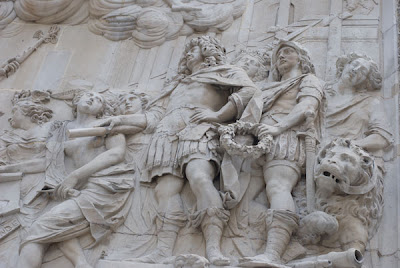Brief:
Take five or six photographs of any subject, but for each one make five exposures, arranged around what you have measured as the best exposure.
The first should be one stop darker, the second half a stop, the third average, the fourth half a stop lighter and the fifth one stop lighter.
These are bracketed exposures of the top of 30 St Mary Axe (The Gherkin). Ordinarily, I would have cloned out the small object on the left, but decided not to do any editing on these because the purpose of the exercise is to concentrate on the effect of changing exposure. The 'correct' image is the one in the middle.
I would say that the last 3 are the most acceptable, with the penultimate image showing the most realistic balance between foreground and background.
In all of these examples, I've adjusted the shutter speed in order to maintain depth of field.
In these shots of The Golden Hind, I think I prefer the penultimate image. Though it was an overcast day, the final image appears a little too dark. Again, the third image is 'correctly' exposed according to the meter in my camera.
These shots are of the Monument which commemorates the Great Fire of London. These are the results I expected as I have photographed light colour subjects before, and they are always underexposed because the camera is trying to render them as 18% grey. In this instance the most acceptable exposure is the first one which is a full stop over the 'correct' exposure.
For comparison purposes, I found a dark subject. This is part of a statue near Leicester Square. The final image is the most accurate and is a full stop under the 'correct' exposure.
This view of the Thames, taken from London Bridge is most acceptable in the fourth exposure because it is relatively more saturated though still lacking in contrast. The final image is a little too dark for my taste.

























No comments:
Post a Comment